Adhiguna Kuncoro
DiPaCo: Distributed Path Composition
Mar 15, 2024Abstract:Progress in machine learning (ML) has been fueled by scaling neural network models. This scaling has been enabled by ever more heroic feats of engineering, necessary for accommodating ML approaches that require high bandwidth communication between devices working in parallel. In this work, we propose a co-designed modular architecture and training approach for ML models, dubbed DIstributed PAth COmposition (DiPaCo). During training, DiPaCo distributes computation by paths through a set of shared modules. Together with a Local-SGD inspired optimization (DiLoCo) that keeps modules in sync with drastically reduced communication, Our approach facilitates training across poorly connected and heterogeneous workers, with a design that ensures robustness to worker failures and preemptions. At inference time, only a single path needs to be executed for each input, without the need for any model compression. We consider this approach as a first prototype towards a new paradigm of large-scale learning, one that is less synchronous and more modular. Our experiments on the widely used C4 benchmark show that, for the same amount of training steps but less wall-clock time, DiPaCo exceeds the performance of a 1 billion-parameter dense transformer language model by choosing one of 256 possible paths, each with a size of 150 million parameters.
DiLoCo: Distributed Low-Communication Training of Language Models
Nov 14, 2023



Abstract:Large language models (LLM) have become a critical component in many applications of machine learning. However, standard approaches to training LLM require a large number of tightly interconnected accelerators, with devices exchanging gradients and other intermediate states at each optimization step. While it is difficult to build and maintain a single computing cluster hosting many accelerators, it might be easier to find several computing clusters each hosting a smaller number of devices. In this work, we propose a distributed optimization algorithm, Distributed Low-Communication (DiLoCo), that enables training of language models on islands of devices that are poorly connected. The approach is a variant of federated averaging, where the number of inner steps is large, the inner optimizer is AdamW, and the outer optimizer is Nesterov momentum. On the widely used C4 dataset, we show that DiLoCo on 8 workers performs as well as fully synchronous optimization while communicating 500 times less. DiLoCo exhibits great robustness to the data distribution of each worker. It is also robust to resources becoming unavailable over time, and vice versa, it can seamlessly leverage resources that become available during training.
On "Scientific Debt" in NLP: A Case for More Rigour in Language Model Pre-Training Research
Jun 05, 2023Abstract:This evidence-based position paper critiques current research practices within the language model pre-training literature. Despite rapid recent progress afforded by increasingly better pre-trained language models (PLMs), current PLM research practices often conflate different possible sources of model improvement, without conducting proper ablation studies and principled comparisons between different models under comparable conditions. These practices (i) leave us ill-equipped to understand which pre-training approaches should be used under what circumstances; (ii) impede reproducibility and credit assignment; and (iii) render it difficult to understand: "How exactly does each factor contribute to the progress that we have today?" We provide a case in point by revisiting the success of BERT over its baselines, ELMo and GPT-1, and demonstrate how -- under comparable conditions where the baselines are tuned to a similar extent -- these baselines (and even-simpler variants thereof) can, in fact, achieve competitive or better performance than BERT. These findings demonstrate how disentangling different factors of model improvements can lead to valuable new insights. We conclude with recommendations for how to encourage and incentivize this line of work, and accelerate progress towards a better and more systematic understanding of what factors drive the progress of our foundation models today.
A Natural Bias for Language Generation Models
Dec 19, 2022



Abstract:After just a few hundred training updates, a standard probabilistic model for language generation has likely not yet learnt many semantic or syntactic rules of natural language, which inherently makes it difficult to estimate the right probability distribution over next tokens. Yet around this point, these models have identified a simple, loss-minimising behaviour: to output the unigram distribution of the target training corpus. The use of such a crude heuristic raises the question: Rather than wasting precious compute resources and model capacity for learning this strategy at early training stages, can we initialise our models with this behaviour? Here, we show that we can effectively endow our model with a separate module that reflects unigram frequency statistics as prior knowledge. Standard neural language generation architectures offer a natural opportunity for implementing this idea: by initialising the bias term in a model's final linear layer with the log-unigram distribution. Experiments in neural machine translation demonstrate that this simple technique: (i) improves learning efficiency; (ii) achieves better overall performance; and (iii) appears to disentangle strong frequency effects, encouraging the model to specialise in non-frequency-related aspects of language.
Transformer Grammars: Augmenting Transformer Language Models with Syntactic Inductive Biases at Scale
Mar 01, 2022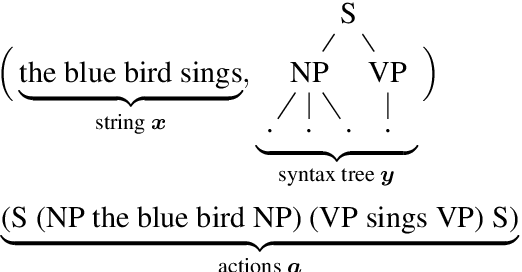

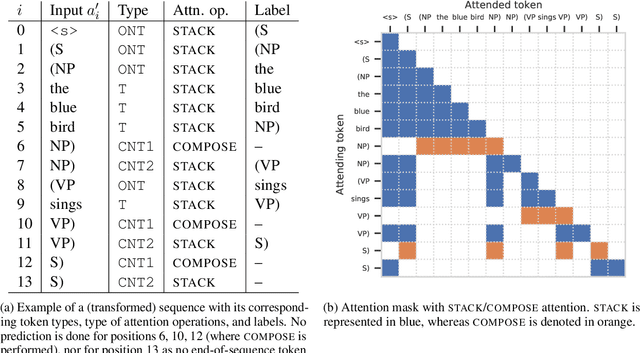

Abstract:Transformer language models that are trained on vast amounts of data have achieved remarkable success at various NLP benchmarks. Intriguingly, this success is achieved by models that lack an explicit modeling of hierarchical syntactic structures, which were hypothesized by decades of linguistic research to be necessary for good generalization. This naturally leaves a question: to what extent can we further improve the performance of Transformer language models, through an inductive bias that encourages the model to explain the data through the lens of recursive syntactic compositions? Although the benefits of modeling recursive syntax have been shown at the small data and model scales, it remains an open question whether -- and to what extent -- a similar design principle is still beneficial in the case of powerful Transformer language models that work well at scale. To answer these questions, we introduce Transformer Grammars -- a novel class of Transformer language models that combine: (i) the expressive power, scalability, and strong performance of Transformers, and (ii) recursive syntactic compositions, which here are implemented through a special attention mask. We find that Transformer Grammars outperform various strong baselines on multiple syntax-sensitive language modeling evaluation metrics, in addition to sentence-level language modeling perplexity. Nevertheless, we find that the recursive syntactic composition bottleneck harms perplexity on document-level modeling, providing evidence that a different kind of memory mechanism -- that works independently of syntactic structures -- plays an important role in the processing of long-form text.
Scaling Language Models: Methods, Analysis & Insights from Training Gopher
Dec 08, 2021


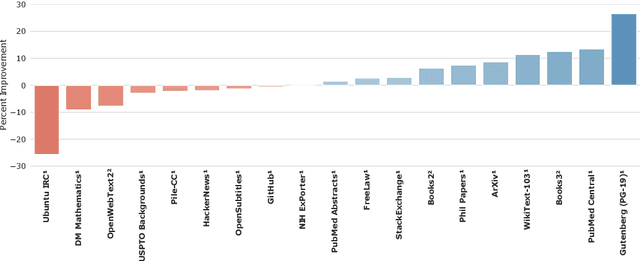
Abstract:Language modelling provides a step towards intelligent communication systems by harnessing large repositories of written human knowledge to better predict and understand the world. In this paper, we present an analysis of Transformer-based language model performance across a wide range of model scales -- from models with tens of millions of parameters up to a 280 billion parameter model called Gopher. These models are evaluated on 152 diverse tasks, achieving state-of-the-art performance across the majority. Gains from scale are largest in areas such as reading comprehension, fact-checking, and the identification of toxic language, but logical and mathematical reasoning see less benefit. We provide a holistic analysis of the training dataset and model's behaviour, covering the intersection of model scale with bias and toxicity. Finally we discuss the application of language models to AI safety and the mitigation of downstream harms.
IndoNLG: Benchmark and Resources for Evaluating Indonesian Natural Language Generation
Apr 16, 2021
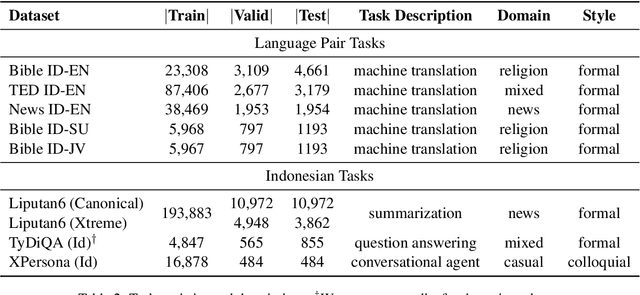


Abstract:A benchmark provides an ecosystem to measure the advancement of models with standard datasets and automatic and human evaluation metrics. We introduce IndoNLG, the first such benchmark for the Indonesian language for natural language generation (NLG). It covers six tasks: summarization, question answering, open chitchat, as well as three different language-pairs of machine translation tasks. We provide a vast and clean pre-training corpus of Indonesian, Sundanese, and Javanese datasets called Indo4B-Plus, which is used to train our pre-trained NLG model, IndoBART. We evaluate the effectiveness and efficiency of IndoBART by conducting extensive evaluation on all IndoNLG tasks. Our findings show that IndoBART achieves competitive performance on Indonesian tasks with five times fewer parameters compared to the largest multilingual model in our benchmark, mBART-LARGE (Liu et al., 2020), and an almost 4x and 2.5x faster inference time on the CPU and GPU respectively. We additionally demonstrate the ability of IndoBART to learn Javanese and Sundanese, and it achieves decent performance on machine translation tasks.
Pitfalls of Static Language Modelling
Feb 03, 2021
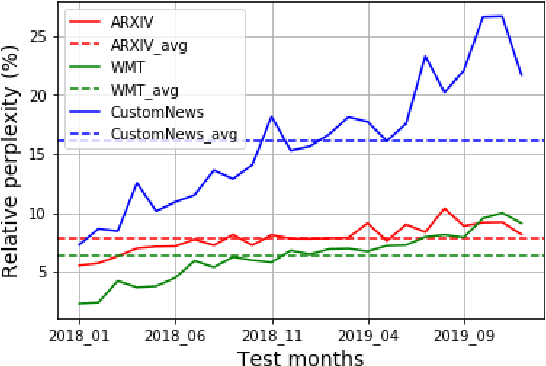

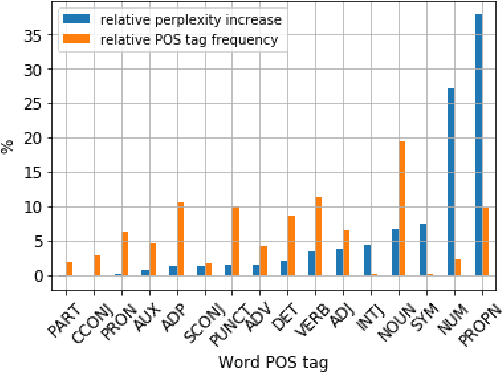
Abstract:Our world is open-ended, non-stationary and constantly evolving; thus what we talk about and how we talk about it changes over time. This inherent dynamic nature of language comes in stark contrast to the current static language modelling paradigm, which constructs training and evaluation sets from overlapping time periods. Despite recent progress, we demonstrate that state-of-the-art Transformer models perform worse in the realistic setup of predicting future utterances from beyond their training period -- a consistent pattern across three datasets from two domains. We find that, while increasing model size alone -- a key driver behind recent progress -- does not provide a solution for the temporal generalization problem, having models that continually update their knowledge with new information can indeed slow down the degradation over time. Hence, given the compilation of ever-larger language modelling training datasets, combined with the growing list of language-model-based NLP applications that require up-to-date knowledge about the world, we argue that now is the right time to rethink our static language modelling evaluation protocol, and develop adaptive language models that can remain up-to-date with respect to our ever-changing and non-stationary world.
Syntactic Structure Distillation Pretraining For Bidirectional Encoders
May 27, 2020


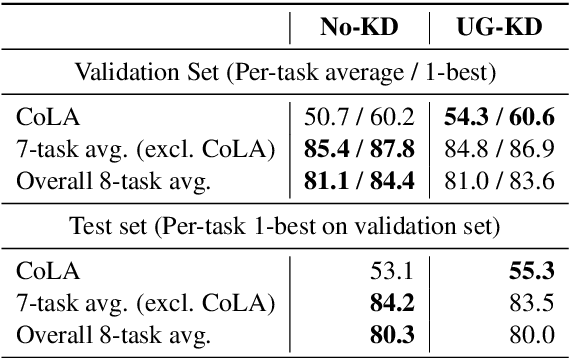
Abstract:Textual representation learners trained on large amounts of data have achieved notable success on downstream tasks; intriguingly, they have also performed well on challenging tests of syntactic competence. Given this success, it remains an open question whether scalable learners like BERT can become fully proficient in the syntax of natural language by virtue of data scale alone, or whether they still benefit from more explicit syntactic biases. To answer this question, we introduce a knowledge distillation strategy for injecting syntactic biases into BERT pretraining, by distilling the syntactically informative predictions of a hierarchical---albeit harder to scale---syntactic language model. Since BERT models masked words in bidirectional context, we propose to distill the approximate marginal distribution over words in context from the syntactic LM. Our approach reduces relative error by 2-21% on a diverse set of structured prediction tasks, although we obtain mixed results on the GLUE benchmark. Our findings demonstrate the benefits of syntactic biases, even in representation learners that exploit large amounts of data, and contribute to a better understanding of where syntactic biases are most helpful in benchmarks of natural language understanding.
Scalable Syntax-Aware Language Models Using Knowledge Distillation
Jun 14, 2019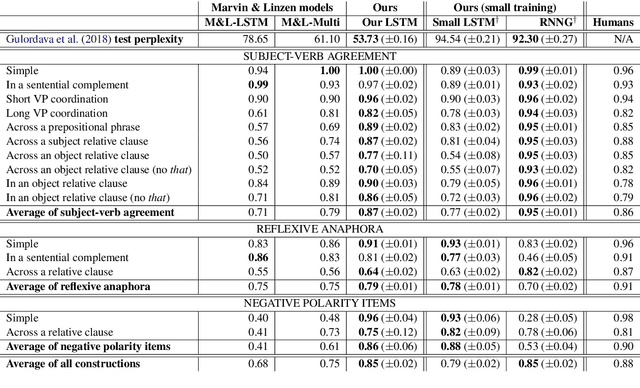
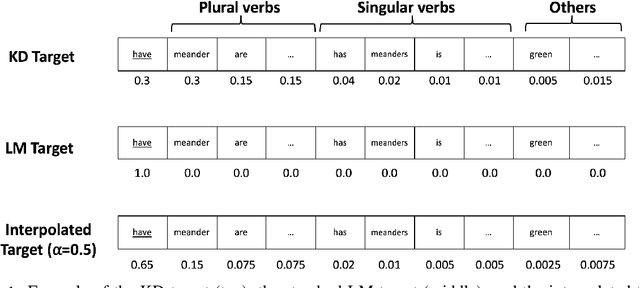
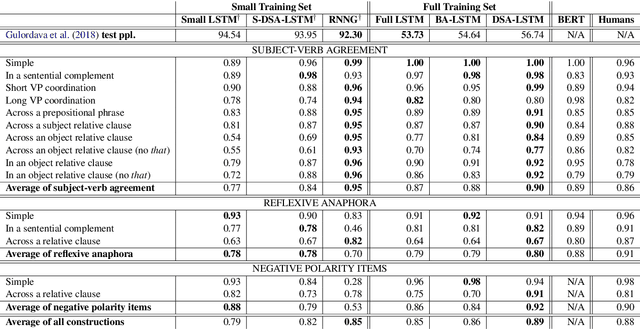
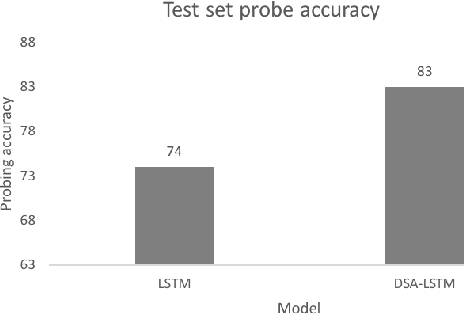
Abstract:Prior work has shown that, on small amounts of training data, syntactic neural language models learn structurally sensitive generalisations more successfully than sequential language models. However, their computational complexity renders scaling difficult, and it remains an open question whether structural biases are still necessary when sequential models have access to ever larger amounts of training data. To answer this question, we introduce an efficient knowledge distillation (KD) technique that transfers knowledge from a syntactic language model trained on a small corpus to an LSTM language model, hence enabling the LSTM to develop a more structurally sensitive representation of the larger training data it learns from. On targeted syntactic evaluations, we find that, while sequential LSTMs perform much better than previously reported, our proposed technique substantially improves on this baseline, yielding a new state of the art. Our findings and analysis affirm the importance of structural biases, even in models that learn from large amounts of data.
 Add to Chrome
Add to Chrome Add to Firefox
Add to Firefox Add to Edge
Add to Edge